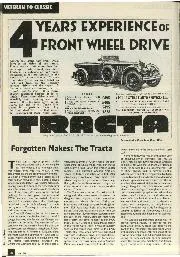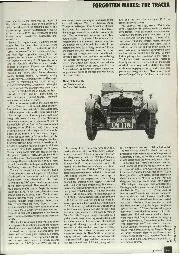

Forgotten Makes: The Tracta
These days a large proportion of the motoring population is drawn along by its front wheels. But in vintage times front-wheel drive was little known. It was some years before…
Sir,
The nostalgic article on the 1922 RollsRoyce ” Silver Ghost/’ by A. C. Molyneux (December issue), prompts a few comments by way of a footnote. If the curious and, maybe, crude magneto brake was really an afterthought as suggested, it was at all events a very persistent one, for it dates from before the last war. The engine was so quiet that even the small noise caused by magnetic torque-fluctuations of the armature at low speeds was considered obtrusive, like the oil jet that kept tapping against the crankshaft of the experimental 8-litre Bentley. The small size of the front shock absorbers was deceptive : the miniature spring-loaded leather cone clutch was effective on both faces, so that it presented double its apparent area. The extra oil supply to the base of the cylinders was originally designed as a precautionary measure to operate at anything beyond about two-thirds throttle. Momentary blipping of the accelerator when the engine started would therefore provide any extra lubrication if it was really wanted (e.g., after standing a long time) without opening the bonnet or plying a screwdriver. Incidentally, a curious recommendation prior to the last war was to cure sticking rings by injecting a little paraffin through the extra oil pipe. Shades of Redex treatment !
As might be expected, fuel consumption varied a good deal according to the performance demanded. The 15 m.p.g. quoted is probably a fair average figure for ordinary use, but the following authentic earlier data obtained under official observation are worth noting :1908 T.T. C. S. Rolls won at 39.4 m.p.h. and 25/20 m.p.g. (20 h.p.).
1908 2,000 miles R.A.C. Trial. Weight, 2 tons 1 cwt., 20.1 m.p.g. (40-50 h.p.).
1911 Top gear test, London-Edinburgh -London, 2 tons 7 cwt., 24.82 m.p.g., followed by 78.26 m.p.h., at Brooklands.
All this would be on a ratio near 3 to 1.
It makes you think. So does the naked copper inlet pipe and manifold, which looked really beautiful when burnished, and worked well, perhaps because of, rather than in spite of, its lack of heating. A cool mixture, if not too ” blobby,” means a heavier combustible charge, and hence increased torque. From the graph, engine torque was at its highest about 500 r.p.m., which explains the uncanny pulling power at 15-20 m.p.h. on top gear. Strangely enough, the falling torque at higher speeds was not unpleasantly obvious. After toying with the idea, however, I feel that the engine—or even half of it—would be too heavy in relation to its power output for installation in a light chassis as a synthetic vintage special, but I am open to conviction. Has anyone tried it ?
An item that deserves mention is the exceedingly neat brake compensators, which consisted of miniature differential gears coupling the two halves of divided cross-shafts abaft the gearbox. The same arrangement was, of course, favoured by W. 0. Bentley. Though perhaps unnecessarily expensive, there is something ;esthetically satisfying about this feature, and it always seemed a pity it was normally hidden from view. I am, Yours, etc.,
Cheshire. J. R. E.